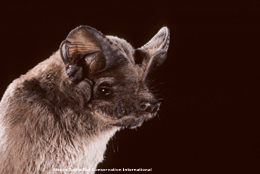Animal Fact Sheet: Mexican Free-tailed Bat |
Identifying Features The Mexican free-tailed bat (Tadarida brasiliensis) is a medium sized bat. Their fur is reddish to dark brown or gray in color. They have broad, black, forward pointing ears, and wrinkled lips. Their tails extend more than one third beyond the tail membranes; most other bats have tails that are completely enclosed within the tail membranes. Their wings are long and narrow. |
 |
Migration/Hibernation Most of these bats migrate south to Central America and Mexico during the winter. |
Habitat Mexican free-tails prefer to roost in caves, but will also choose attics, under bridges, or in abandoned buildings. They choose roosts near water. The water attracts the insects they eat, as well as allowing them the opportunity to drink. |
Range Mexican free-tails are found in the western United States, south through Mexico, Central America and into northern South America. |
Wild Status These bats are not currently threatened or endangered. |
Diet Free-tail bats consume enormous amounts of moths and other insects. Some roosts are known to contain millions of bats. In those colonies it is estimated that 250 tons of insects can be consumed every night. |
Predators Snakes, raccoons, house cats, owls, and other predators sometimes manage to gain access to the roosts. If a baby falls to the cave floor the mother will not come to its rescue giving predators a chance for a quick meal. |
Reproduction A single free-tail baby bat is born during the summer. Young Mexican free-tailed bats roost separately from their mothers. Babies roost in the highest reaches of the cave, where temperatures are the warmest. The warm conditions are essential for rapid growth and survival. In the large maternity colonies of Mexican free-tails, the mother must find her own pup among the thousands. It is thought that she locates her baby by recognizing its individual call. |
Life Span These bats may have a life span of up to 18 years. |
Size Their weight is between 0.4-0.5 oz (11- 14 g) and their wingspan is between 12-14 in (30-35 cm). |
Extra Fun-facts
|










